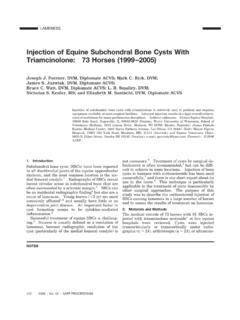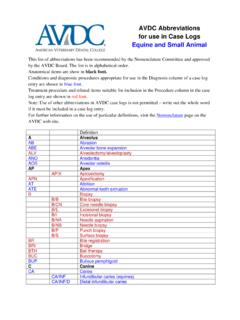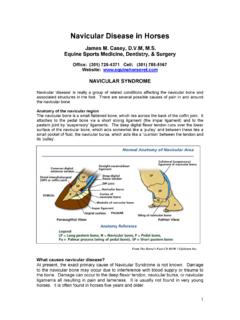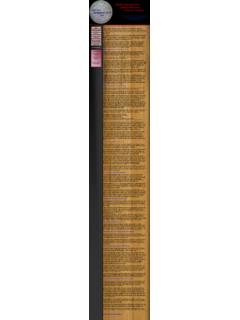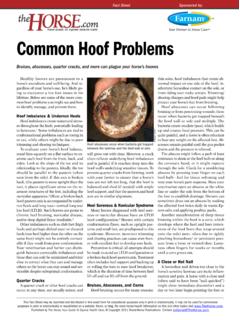Transcription of Ultrasonography of the Equine Tarsus - IVIS
1 Ultrasonography of the Equine TarsusMary Beth Whitcomb, DVMU ltrasound of the Tarsus , like other joints in the horse, provides valuable information to documentand characterize soft tissue and osseous injury. The collateral ligaments, superficial digital flexortendon, long digital extensor tendon, gastrocnemius tendon, and peroneus tertius are most commonlyaffected, but injuries to all tendons and ligaments can be seen. The frequency of wounds makes thetarsus a prime target for septic arthritis, tenosynovitis, and bursitis. Ultrasound can be used toshow involvement of synovial structures in many cases of sepsis. Author s address: Department ofSurgical & Radiological Sciences, School of Veterinary Medicine, University of California at Davis,Davis, CA 95616; e-mail: 2006 IntroductionUltrasonographic imaging of Equine joints is gener-ally well accepted as a valuable diagnostic modalityfor tendon, ligament, and other soft tissue with other joints such as the shoulderand stifle, tarsal ultrasound may easily be consid-ered the most challenging.
2 The complex anatomyof the Tarsus , including several tendons and liga-ments coursing in multiple directions and numeroussynovial structures, contributes to this solid understanding of tarsal anatomy is critical toperforming a successful ultrasound has traditionally been the primary im-aging modality for hock disease, but it provides littleto no information on tendon or ligament injury orthe appearance of synovial structures. Ultrasoundremains the most cost effective imaging modality todiagnose soft tissue injuries and can be performedby motivated practitioners with basic ultrasoundskills and equipment. Similar to other regions inthe horse, the information gained from tarsal ultra-sound often provides a diagnosis when physical-exam findings and radiographic evaluation havefailed to reveal the source of lameness and/or clinicalsigns.
3 Although computed tomography and mag-netic resonance imaging of the Tarsus have beendescribed, the use of these imaging modalities is notyet practical in most ,2 Common indications for tarsal ultrasound includedistention of synovial structures, hock swelling,and/or wounds and lacerations. Ultrasound is veryuseful to elucidate the cause of tarsal swelling bydifferentiating between cellulitis, effusion of syno-vial structure(s), and/or tendon or ligament Equine Tarsus is a common site for puncturewounds and lacerations that often involve synovialstructures, tendons, and/or ligaments. Communi-cation with these structures is often difficult to de-termine by palpation alone. Contrast radiographycan be helpful for this purpose, but it gives littleinformation on associated soft tissue injury.
4 Ultra-sound is well suited to document wound communi-cation with synovial structures and/or bone and toassess the degree of soft tissue injury. Ultrasoundcan also help to differentiate between septic andnon-septic synovitis/tenosynovitis and can identifythe best location to obtain synovial fluid samples forAAEP PROCEEDINGS Vol. 52 200613IN-DEPTH: HOCKSNOTES analysis. Ultrasound should also be performed inhorses with radiographic evidence of fracture(s) sus-picious for collateral ligament avulsion and inhorses with evidence of osteomyelitis in close prox-imity to synovial structures. Less common indica-tions include nuclear scintigraphic findings ofincreased radiopharmaceutical uptake in the hockregion and lameness localized to the purpose of this paper is to review the sono-graphic anatomy of the Tarsus , describe techniquesused to image the dorsal, medial, lateral, and plan-tar structures of the Tarsus , and review the distri-bution of tendon, ligament, bone, and synovialinjuries during the study period (1999 2005)from the Large Animal Ultrasound Service at theUniversity of California, Davis, Veterinary MedicalTeaching Hospital (UCD-VMTH).
5 Although the ul-trasonographic appearance and clinical findings ofmany soft tissue injuries of the Tarsus have beenpreviously described in the veterinary literature,3 9the distribution of injuries from a large patient pop-ulation has not been Ultrasonographic TechniqueUltrasonographic evaluation of the Equine Tarsus isbest divided into four regions (dorsal, medial, lat-eral, and plantar) because of the large number oftendons, ligaments, and synovial evaluated from the dorsum include theperoneus tertius (PT), cranial tibial tendons of at-tachment (primarily cunean tendon), long digitalextensor (long DE) tendon/tendon sheath, and tibio-tarsal (TT) joint capsule. The joint capsules of theproximal intertarsal (PIT), distal intertarsal (DIT),and tarsometatarsal (TMT) joints can also be eval-uated from the dorsum but are not typically seen inmost horses.
6 Medial structures include the super-ficial and deep components of the medial collateralligament (MCL). The cunean tendon is also imagedmedially. Lateral structures include the lateraldigital extensor (lat DE), tendon/tendon sheath, andsuperficial and deep components of the lateral col-lateral ligament (LCL). Structures evaluated fromthe plantar aspect of the Tarsus include the longplantar ligament (LPL), superficial digital flexortendon (SDFT) and its retinacular calcaneal attach-ments, gastrocnemius (GN) tendon, deep digitalflexor tendon (DDFT), and small medial synovial structures include the subcutane-ous bursa, calcaneal bursa, GN bursa, tarsal sheath,and plantar pouches of the TT should be sedated with either detomidineHCla( mg/kg IV) or xylazine HClb( mg/kg IV).
7 Butorphanol tartratec( IV) should be used with intractable horses orthose with severe pain or lameness. When avail-able, horses should be restrained in stocks for equip-ment and operator safety. As usual, the bestimages are obtained by clipping the hair of the hockregion with #40 blades, washing the skin with soapand water, and applying ultrasound coupling saturation can be used, but horses can be-come irritated by alcohol running down their of all structures can be accomplishedusing standard ultrasound equipment available inmost Equine practices. A high-frequency (7 14 MHz) linear transducer used for most musculoskel-etal imaging is also well suited for tarsal tendon-format transducer (commonly known as a T probe) is ideal; however, a rectal-format trans-ducer will also produce diagnostic images.
8 A scan-ning depth of 4 6 cm is appropriate for moststructures. Whenever possible, a program de-signed for musculoskeletal imaging should be se-lected. A standoff pad is not necessary but may beuseful when evaluating bony Dorsal StructuresPeroneus TertiusThe PT can be followed from its origin at the exten-sor fossa of the distal femur throughout the length ofthe tibia to its insertions on the distal tarsal bonesand proximal metatarsus (Fig. 1). The tendon isquite large in the proximal and midtibia regionswhere it is located deep to the long DE muscle PT becomes smaller and more superficially lo-cated in the distal tibia region (Fig. 2) and bifurcatesinto two primary tendons of insertion at the level ofthe talus. The tendons of insertion are often chal-Fig.
9 1. Anatomy specimen showing location and orientation ofdorsal tarsal structures. Note the relative lateral location of thelong digital extensor tendon (Lo) adjacent to the peroneus tertius(PT), the close association of the dorsal tendons of attachment ofthe PT and cranial tibial (CT) muscle, and the medial location andorientation of the cunean tendon (Cu). LA, lateral digital exten-sor Vol. 52 AAEP PROCEEDINGSIN-DEPTH: HOCKS lenging to differentiate from the dorsal tendon ofinsertion of the cranial tibial muscle. PT abnor-malities are primarily limited to ruptures that canoccur secondary to falls, limb entrapment, or full-limb casting. Ruptures are most common in themid and distal tendon regions but can also occur atthe affected tendon is usually mark-edly enlarged with a diffusely hypoechoic and mot-tled appearance in the region of the rupture with anabsence of linear fibers on longitudinal views ( ).
10 Relaxation artifact of the proximal portion ofthe tendon may also be present in cases of Tibial/Cunean TendonThe cranial tibial muscle belly is located deep to thePT tendon in the mid/distal tibia region and has twotendons of attachment. These include the cuneantendon (medial tendon of attachment) and the dorsaltendon that inserts onto the dorsal surfaces of thethird tarsal and third metatarsal bones. Comparedwith the dorsal tendon, the cunean tendon is readilyimaged. The tendon begins to form in the distaltibia/proximal talus region deep to and between thePT lobulations that form immediately proximal tothe PT bifurcation (Fig. 4, A and B). From thislocation, the cunean tendon quickly courses medi-ally in a transverse direction toward its insertiononto the fused first and second tarsal bones.
